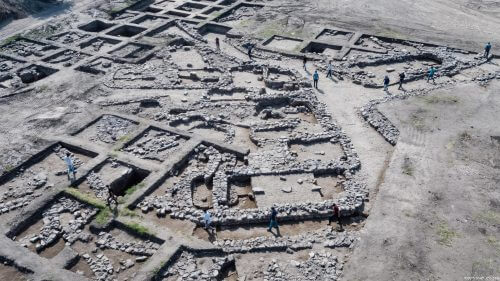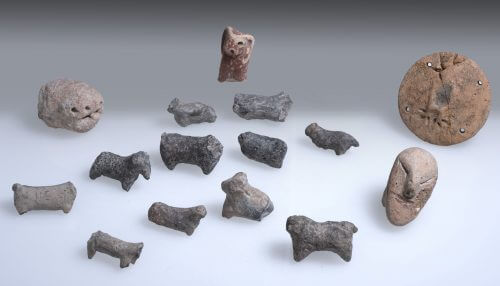Excavation managers: "This is the New York of our region in the Early Bronze Age; A cosmopolitan and planned city where thousands of people lived"

A huge city, the largest and central known in Israel from about 5000 years ago, was discovered in large-scale excavations by the Antiquities Authority together with thousands of youth and volunteers, which have been conducted for the past two and a half years in the Ein Iron area in northern Sharon. The excavations, which reveal a city that stretched over about 650 dunams and was inhabited by about 6,000 people, are being carried out before the construction of the entrance interchange to the city of Harish, a project initiated and funded by Netibi Israel.
The extensive excavations at the Ein Asor archaeological site, which is located near Wadi Ara, reveal a planned city from the Early Bronze Age 1B (end of the fourth millennium BC), surrounded by a fortification wall with residential and public areas, streets and alleys. In the excavations that went deeper under the houses of this city, an even more ancient extensive settlement was discovered, from the Chalcolithic period, which is 7,000 years old. It seems that two abundant springs that arose in the area in ancient times, were the attraction factor to the site throughout the ages.
About 5,000 youths and volunteers participated in the excavations as part of the Antiquities Authority's heritage project, which aims to create an emotional and experiential connection to the past and cultural heritage, and to develop a sense of belonging to the country and awareness of the importance of preserving its antiquities. Among the participants were the students of the Meta Menashe Regional Council, trainees of pre-military preparatory schools, students of the Eretz Yisrael and Archeology studies majors, service year and Nahal nuclear trainees, students from special education, students and joint groups of Jews and Arabs, who came in cooperation with the SHARE international organization. According to Noa Shaul, an instructor on behalf of the Antiquities Authority: "The challenges posed by the archaeological dig to the students, and the uncovering of the findings, also contributed to their personal development and to enriching their knowledge of the country's landscapes, its sites and its history."
According to Itai Elad, Dr. Yitzhak Paz and Dr. Dina Shalem, the managers of the excavation on behalf of the Antiquities Authority, "There is no doubt that this site dramatically changes what we know about the nature of the period and the beginnings of urbanization in the Land of Israel. This is a fascinating period in the history of the Land of Israel - the Canaan of those days, whose population is undergoing transformations that change its face completely. The rural population is giving way to a complex society, mostly living in urban settings. These are the first steps of the Canaanite culture in Israel, which forms an identity for itself in the urban sites that were founded, and hence the enormous importance of the ancient city that was uncovered in the north of Sharon. Such a city could not have grown without a guiding hand and an administrative mechanism behind its establishment. Its impressive design and the fact that vessels imported from Egypt and seal impressions were discovered at the site are proof of this. A huge city was located here - Megalopolis in relation to the Early Bronze Age, in which thousands of people lived who made a living from agriculture and had trade relations with different regions and even with different cultures and kingdoms in the area."

In the public area of the city, the archaeologists discovered an unusual ritual complex (temple) with its impressive dimensions, and in its courtyard a huge stone basin for liquids that was used for ritual ceremonies held there. Inside the temple, a device with burnt animal bones was discovered - evidence of sacrificial sacrifices, as well as rare figurines (statuettes), including a human head and a seal impression of a person holding up his hands and holding the figure of an animal next to him. These findings allow us to look beyond the material to the spiritual life of the large community that lives on the site."
The surprising findings make it possible, for the first time, to define the cultural characteristics of the inhabitants of this region in ancient times. These, made a living from agriculture thanks to the nearby springs, and the spaces that were used for crops. The remains of the residential buildings, the various facilities and the public buildings that were uncovered, testify to an organized society and a social hierarchy that existed at that time. The excavation uncovered millions of fragments of pottery, flintware, basalt stoneware brought to the place, and more.
Following the discovery of the unique site in the excavations of the Antiquities Authority, Netibi Israel made planning changes in order to keep the impressive city in its place. The archaeological remains are documented by advanced means, they will be covered in a controlled manner, studied and investigated by the Antiquities Authority researchers, and the new interchange will be built high above them, so that the site will be preserved for future generations.

6 תגובות
I wonder if the aforementioned animal figurine was identified? Also, why insist on identifying the area as part of the "Land of Israel"? Isn't there some kind of tendency here, although Toli doesn't even intend it? Moreover, from all the pre-biblical and biblical finds, there really is no picture of a Hebrew-Jewish settlement, at least as it is presented in the Bible, or alternatively, is there perhaps a fear that the pagan, ritual evidences did indicate the Jewish worship, which many and good people seek to eliminate?
According to what is told in the Torah, the Canaanites lived in the land of the land - one of the seven peoples of Canaan? Is it possible to compare the found figurines - to the figurines that have already been found? The stone figurines were produced during the Stone Age, and the city - probably when urbanization began in Canaan.
Cedar, documents can also be on pottery. Sumerian literature example 3500 BC. And later Babylon and Shumer. Read Shmuel Noah Kramer's book "History Begins in Homer" and a book published about a year ago by Natan Wasserman and Yigal Bloch "The Amorites"
It is not certain that documents will be preserved in the humid climate of the Land of Israel. Were documents preserved about the construction of cities in Egypt and Mesopotamia?
How can there be a settlement from the Chalcolithic period from approximately 7000 years BC? The Chalcolithic began in 4500 BC. No ?
Reason suggests that in a city of this size and being a planned city there should also be written evidence. It is impossible to plan a city without a work plan, without blueprints and without work instructions, and all of these require literacy. need documents